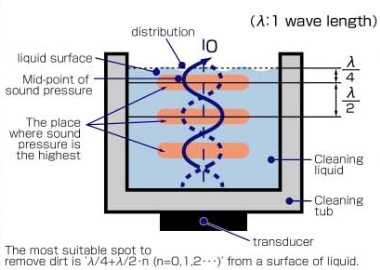The Principles of Ultrasonic Cleaning.
Ultrasonic Cleaning Theory
What is an ultrasonic wave?
It is well known that when dolphins communicate with each other and when bats are locating their prey, an ultrasonic wave is being used. An ultrasonic wave may be defined as a high frequency sound wave above ~20kHz, i.e., beyond the range of human hearing. Ultrasonics is the science of sound waves above the limits of human audibility.
Other features of ultrasounds include:
- An ultrasonic wave may be transmitted in either a solid, liquid or gas
- Within a solid, an ultrasonic wave passes as a longitudinal wave
- An ultrasonic wave has sound pressure with high change grade and power density.
Considering these features of an ultrasonic wave, there are many possible technological applications in the physical sciences which may utilize these unique characteristics of ultrasound.
Applications
There are two main ways to use ultrasound.
- The first group involves using the vibrations as a positive energy to perform an action. This is the case of applications such as washing (ultrasonic cleaner), touch (ultrasonic welding machine), cutting (ultrasonic cutter), misting (ultrasonic atomization and ultrasonic humidifier).
- In the second group, ultrasounds are used as a means to collect information through the signature of the reflective wave. This includes applications such as exploring (fishfinder), evaluating (medical equipment), testing (ultrasonic microscope, ultrasonic flaw detection video equipment), gaugeing (air, ultrasonic level meter).
Ultrasonic Cleaning
Ultrasonic cleaning uses ultrasound energy to remove particles from the surface of the object to be cleaned. In the illustration below, a sound wave - one wave length (Lambda) - is shown passing through a liquid in a cleaning tank. The highest energy occurs at the peak of the wave. It is possible to predict the location of the greatest cleaning energy given a specific frequency and knowledge of the acoustic velocity.
1 wave length (Lambda) = acoustic velocity (c) / frequency (f)
Lambda = c / f
where: Lambda = wave length (m)
c: Acoustic velocity of washing liquid (m/s)
f: Frequency (Hz)
In the case of water; c ~ 1500 m/s


If we consider 40 kHz frequency, we can obtain the wavelength distance as:
1500000 (mm/s) / 40000 (Hz) = 37.5 (mm) -> 1 wave length
Each peak of the wave will be located at: 37.2 / 2 -> 19 mm
Therefore, each interval of 19mm results in the most efficient removal of particles.
Types of Ultrasonic Cleaning
There are two types of ways to apply ultrasonic power for cleaning:
- By cavitation - Low frequency cleaning
- By accelerating the molecules of the cleaning liquid - High frequency
